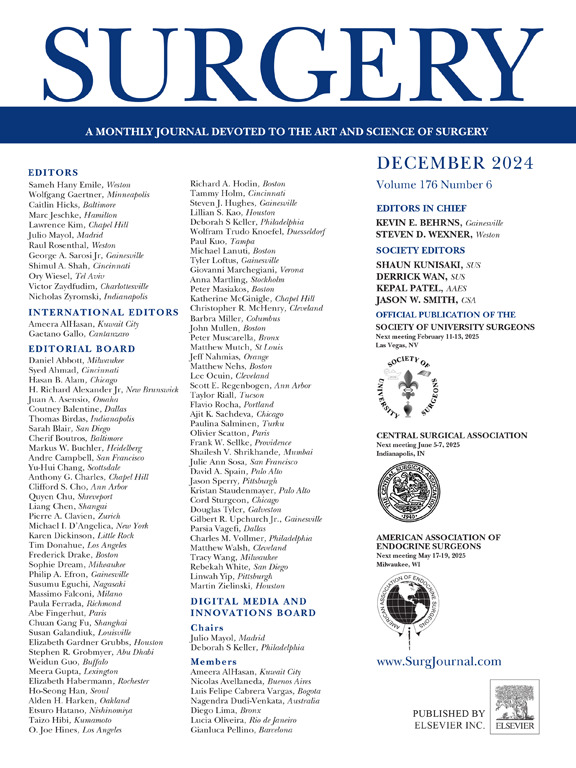Is preoperative smoking status a predictor of postoperative outcomes after esophagectomy for squamous cell carcinoma in a high-volume centre?
IF 3.2
2区 医学
Q1 SURGERY
引用次数: 0
Abstract
Background
Smoking is a major risk factor for esophageal squamous cell carcinoma (ESCC) and is linked to increased postoperative morbidity. However, its impact on long-term survival remains unclear. This study evaluated the influence of preoperative smoking status on postoperative complications and survival following esophagectomy for ESCC in a high-volume center.
Methods
Patients who underwent surgery for ESCC between 1996 and 2019 were retrospectively categorized as smokers (S-group) or non-smokers (NS-group). A subgroup analysis was performed to compare active and former smokers. Primary outcomes included major postoperative complications (Clavien-Dindo ≥ III), pulmonary complications, and postoperative mortality at 30 and 90 days. Long-term outcomes included overall survival (OS) and recurrence-free survival (RFS).
Results
Among 694 patients, 97 (14%) were in the NS-group and 597 (86%) in the S-group. Smokers had significantly higher major morbidity rates (37% vs 23%, P = .002), including major pulmonary complications (29% vs 21%, P = .03). Active smoking was associated with increased 30-day mortality (P = .006) and higher rates of acute respiratory distress syndrome (P = .012) compared to former smokers. OS and RFS did not differ significantly between groups. The absence of post-operative smoking data limits long-term outcome interpretation.
Conclusion
Smoking was associated with increased perioperative morbidity, particularly pulmonary complications, but its effect on long-term survival remains uncertain. Structured smoking cessation programs should be integrated into perioperative care. Future studies should incorporate postoperative smoking status to better assess its impact on survival.

在一个大容量中心,术前吸烟状况是食管切除术后鳞状细胞癌预后的预测因子吗?
吸烟是食管鳞状细胞癌(ESCC)的主要危险因素,并与术后发病率增加有关。然而,其对长期生存的影响尚不清楚。本研究在一个大容量中心评估了术前吸烟状况对ESCC食管切除术术后并发症和生存率的影响。方法回顾性地将1996年至2019年接受ESCC手术的患者分为吸烟者(s组)和非吸烟者(ns组)。进行亚组分析,比较活跃吸烟者和戒烟者。主要结局包括术后主要并发症(Clavien-Dindo≥III)、肺部并发症和术后30天和90天的死亡率。长期预后包括总生存期(OS)和无复发生存期(RFS)。结果694例患者中,ns组97例(14%),s组597例(86%)。吸烟者的主要发病率明显更高(37% vs 23%, P = 0.002),包括主要肺部并发症(29% vs 21%, P = 0.03)。与前吸烟者相比,主动吸烟与30天死亡率增加(P = 0.006)和急性呼吸窘迫综合征发生率增加(P = 0.012)相关。OS和RFS组间差异无统计学意义。术后吸烟数据的缺失限制了对长期结果的解释。结论吸烟与围手术期发病率增加有关,尤其是肺部并发症,但其对长期生存的影响尚不确定。有组织的戒烟计划应纳入围手术期护理。未来的研究应纳入术后吸烟状况,以更好地评估其对生存的影响。
本文章由计算机程序翻译,如有差异,请以英文原文为准。
求助全文
约1分钟内获得全文
求助全文
来源期刊

Surgery
医学-外科
CiteScore
5.40
自引率
5.30%
发文量
687
审稿时长
64 days
期刊介绍:
For 66 years, Surgery has published practical, authoritative information about procedures, clinical advances, and major trends shaping general surgery. Each issue features original scientific contributions and clinical reports. Peer-reviewed articles cover topics in oncology, trauma, gastrointestinal, vascular, and transplantation surgery. The journal also publishes papers from the meetings of its sponsoring societies, the Society of University Surgeons, the Central Surgical Association, and the American Association of Endocrine Surgeons.
 求助内容:
求助内容: 应助结果提醒方式:
应助结果提醒方式:


